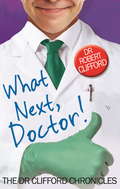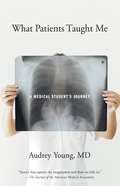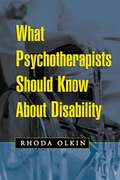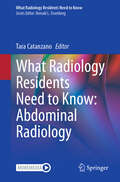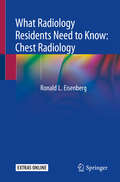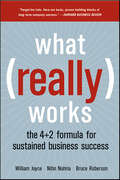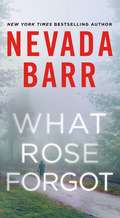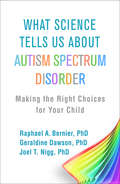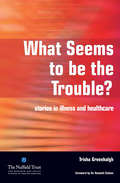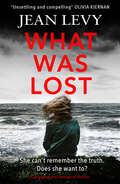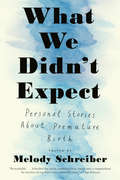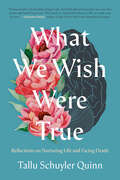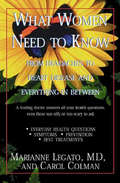- Table View
- List View
What Matters in Medicine: Lessons from a Life in Primary Care
by David LoxterkampPrimary care has come into the limelight with the passage of the Patient Protection and Affordable Care Act, the unchecked and unsustainable rise in American health care expenditures, and the crest of Baby Boomers who are now Medicare-eligible and entering the most health care-intensive period of their lives. Yet how much is really known about primary care? What Matters in Medicine: Lessons from a Life in Primary Care is a look at the past, present, and future of general practice, which is not only the predecessor to the modern primary care movement, but its foundation. Through memoir and conversation, Dr. David Loxterkamp reflects on the heroes and role models who drew him to family medicine and on his many years in family practice in a rural Maine community, and provides a prescription for change in the way that doctors and patients approach their shared contract for good health and a happy life. This book will be useful to those on both sides of primary care, doctors and patients alike.
What Next, Doctor?
by Robert CliffordWhat Next Doctor? is the third book in the hilarious Dr Clifford Chronicles, true-life experiences as G.P. in a West Country practice. This instalment commences when Dr Clifford and his bride wake up to a bizarre confrontation on the first day of their honeymoon - and promptly prescribe themselves champagne as a cure! The patients passing through his life are by turns comic and courageous, lovable and tragic. There's the long-married couple whose recipe for happiness is a row twice a week; the accident- prone ex- miner whose collection of injuries and ailments makes him a medical curiosity; and the elderly couple who turn out to be mother and son - the son is eighty-one! Dr Clifford presents us with an immensely entertaining slice of life- the tragedies and triumphs of ordinary people caught up in the human drama of survival in a world of sickness and ill health. And he tells his tale with all warmth and humour that makes his books a real delight to read.
What Next, Doctor? (The Dr Clifford Chronicles)
by Dr Robert CliffordWhat Next Doctor? is the third book in the hilarious Dr Clifford Chronicles, true-life experiences as G.P. in a West Country practice. This instalment commences when Dr Clifford and his bride wake up to a bizarre confrontation on the first day of their honeymoon - and promptly prescribe themselves champagne as a cure! The patients passing through his life are by turns comic and courageous, lovable and tragic. There's the long-married couple whose recipe for happiness is a row twice a week; the accident- prone ex- miner whose collection of injuries and ailments makes him a medical curiosity; and the elderly couple who turn out to be mother and son - the son is eighty-one!Dr Clifford presents us with an immensely entertaining slice of life- the tragedies and triumphs of ordinary people caught up in the human drama of survival in a world of sickness and ill health. And he tells his tale with all warmth and humour that makes his books a real delight to read.
What Nostalgia Was: War, Empire, and the Time of a Deadly Emotion (Chicago Studies in Practices of Meaning)
by Thomas DodmanNostalgia today is seen as essentially benign, a wistful longing for the past. This wasn't always the case, however: from the late seventeenth century through the end of the nineteenth, nostalgia denoted a form of homesickness so extreme that it could sometimes be deadly. What Nostalgia Was unearths that history. Thomas Dodman begins his story in Basel, where a nineteen-year-old medical student invented the new diagnosis, modeled on prevailing notions of melancholy. From there, Dodman traces its spread through the European republic of letters and into Napoleon's armies, as French soldiers far from home were diagnosed and treated for the disease. Nostalgia then gradually transformed from a medical term to a more expansive cultural concept, one that encompassed Romantic notions of the aesthetic pleasure of suffering. But the decisive shift toward its contemporary meaning occurred in the colonies, where Frenchmen worried about racial and cultural mixing came to view moderate homesickness as salutary. An afterword reflects on how the history of nostalgia can help us understand the transformations of the modern world, rounding out a surprising, fascinating tour through the history of a durable idea.
What Nurses Know and Doctors Don't Have Time to Tell You
by Pat CarrollThis comprehensive, accessible home reference guide addresses a wide range of health concerns-as only a nurse who knows the inside story on healthcare can. <P><P>From headaches to ankle sprains, asthma to zinc remedies, this authoritative resource reveals what everyone needs to know in order to get healthy-and stay that way. The book features hundreds of tips on easing symptoms, promoting healing, following a treatment plan, and solving both the big and small problems that arise when someone is sick, hurt, or in pain. Readers will discover how to: Treat everyday health complaints and minor injuries Heal faster after an injury Get the best results from medicines while reducing side effects Recover more comfortably at home after outpatient surgery .
What Patients Say, What Doctors Hear
by Danielle OfriCan refocusing conversations between doctors and their patients lead to better health? Despite modern medicine’s infatuation with high-tech gadgetry, the single most powerful diagnostic tool is the doctor-patient conversation, which can uncover the lion’s share of illnesses. However, what patients say and what doctors hear are often two vastly different things.Patients, anxious to convey their symptoms, feel an urgency to “make their case” to their doctors. Doctors, under pressure to be efficient, multitask while patients speak and often miss the key elements. Add in stereotypes, unconscious bias, conflicting agendas, and fear of lawsuits and the risk of misdiagnosis and medical errors multiplies dangerously.Though the gulf between what patients say and what doctors hear is often wide, Dr. Danielle Ofri proves that it doesn’t have to be. Through the powerfully resonant human stories that Dr. Ofri’s writing is renowned for, she explores the high-stakes world of doctor-patient communication that we all must navigate. Reporting on the latest research studies and interviewing scholars, doctors, and patients, Dr. Ofri reveals how better communication can lead to better health for all of us.
What Patients Taught Me: A Medical Student's Journey
by Audrey YoungDo sleek high-tech hospitals teach more about medicine and less about humanity? Do doctors ever lose their tolerance for suffering? With sensitive observation and graceful prose, this book explores some of the difficult and deeply personal questions a 23-year-old doctor confronts with her very first dying patient, and continues to struggle with as she strives to become a good doctor. In her travels, the doctor attends to terminal illness, AIDS, tuberculosis, and premature birth in small rural communities throughout the world.
What Psychotherapists Should Know About Disability
by Rhoda OlkinThis comprehensive volume provides the knowledge and skills that mental health professionals need for more effective, informed work with clients with disabilities. Combining her extensive knowledge as a clinician, researcher, and teacher with her personal experience as someone with a disability, Olkin provides an insider's perspective on critical issues that are often overlooked in training. A lucid conceptual framework is presented for understanding disability as a minority experience, one that is structured by social, legal, and attitudinal constraints as well as physical challenges. Illuminating frequently encountered psychosocial themes and concerns, chapters describe a range of approaches to dealing with disability issues in the treatment of adults, children, and families. Topics addressed include etiquette with clients with disabilities; special concerns in assessment, evaluation, and diagnosis; the impact of disability on sexuality and romance, as well as pregnancy, birthing, and parenting; the use of assistive technology and devices; disability and substance abuse; and more. Filled with clinical examples and observations, the volume also discusses strategies for enhancing teaching, training, and research.
What Psychotherapists Should Know About Disability
by Rhoda OlkinThis comprehensive volume provides the knowledge and skills that mental health professionals need for more effective, informed work with clients with disabilities. Combining her extensive knowledge as a clinician, researcher, and teacher with her personal experience as someone with a disability, Olkin provides an insider's perspective on critical issues that are often overlooked in training. A lucid conceptual framework is presented for understanding disability as a minority experience, one that is structured by social, legal, and attitudinal constraints as well as physical challenges. Illuminating frequently encountered psychosocial themes and concerns, chapters describe a range of approaches to dealing with disability issues in the treatment of adults, children, and families. Topics addressed include etiquette with clients with disabilities; special concerns in assessment, evaluation, and diagnosis; the impact of disability on sexuality and romance, as well as pregnancy, birthing, and parenting; the use of assistive technology and devices; disability and substance abuse; and more. Filled with clinical examples and observations, the volume also discusses strategies for enhancing teaching, training, and research.
What Radiology Residents Need to Know: Abdominal Radiology (What Radiology Residents Need to Know)
by Tara CatanzanoThis book provides first year radiology residents an easy to digest, image rich book with key information necessary to learn and succeed on their first abdominal rotations. Current generation learners prefer just in time learning of high impact material, presented in small, quick to assimilate formats. This book is not intended to provide an exhaustive overview of abdominal pathology; rather, it serves to provide foundational knowledge and approaches to imaging of common diseases. Each chapter focuses on an organ system and covers commonly encountered diseases or disorders. Each topic discusses the imaging findings on different imaging modalities, allowing the leaner to see how the same disease process will appear on each modality. This is of benefit even if the trainee has not yet rotated through that modality as it will allow them to build knowledge that can then be more critically applied as they reread the information on that disorder when they rotate on thatmodality. This is an ideal guide for all first-year radiology residents.
What Radiology Residents Need to Know: Breast Imaging (What Radiology Residents Need to Know)
by Priscilla J. Slanetz Vandana DialaniThis book is an introduction to breast imaging, specifically designed for the needs of first through third year residents. While rotating through breast imaging, radiology residents are asked to learn significant amounts of information at a fast and unrelenting pace. However, most current books are densely written and contain far more material than residents need to know. Moreover, the number, variety and quality of images is often limited. What Radiology Residents Need to Know: Breast Imaging answers these needs by presenting the important information in bullet fashion, divided into convenient sub-units, such as “clinical information,” “imaging findings” and “management.” This book covers such topics as breast cancer, benign breast disease, image-guided interventions, pregnant and lactating patients, transgender patients, and male breast disease. In addition, it contains tips on approaching and interpreting mammography, breast ultrasound, and breast MRI studies based on decades of practical experience and teaching residents at the work station as well as a list of common differentials. With liberal use of illustrations in the text and an online bank of many more high-quality images, this book gives readers a comprehensive library of breast imaging scans and serves as an ideal guide for radiology residents.
What Radiology Residents Need to Know: Chest Radiology
by Ronald L. EisenbergThis book is an introduction to chest radiology, specifically designed for the needs of first-year residents. On the first rotation in chest imaging, radiology residents are asked to learn significant amounts of information at a fast and unrelenting pace. However, most current books are densely written and contain far more material than residents need to know. Moreover, the number, variety, and quality of images is often limited. What Radiology Residents Need to Know: Chest Radiology answers these needs by presenting the important information in bullet fashion, divided into convenient sub-units, such as “clinical information,” “imaging findings,” and “management.” In most cases, an individual pathological condition can be presented in one page or less. This book covers such topics as volume loss, pneumonia, pulmonary edema, inhalation diseases, and pulmonary, mediastinal, and pleural tumor imaging. In addition, it contains tips on approaching and interpreting chest radiographs and CT based on decades of practical experience and teaching residents at the work station. With liberal use of illustrations in the text and an online bank of many more high-quality images, this book gives readers a comprehensive library of chest imaging scans and serves as an ideal guide for radiology residents.
What Radiology Residents Need to Know: Musculoskeletal Radiology (What Radiology Residents Need to Know)
by Ronald L. EisenbergThis book is an introduction to musculoskeletal radiology, specifically designed for the needs of first-year residents. On the first rotation in musculoskeletal imaging, radiology residents are asked to learn significant amounts of information at a fast and unrelenting pace. However, most current books are densely written and contain far more material than residents need to know. Moreover, the number, variety and quality of images is often limited.What Radiology Residents Need to Know: Musculoskeletal Radiology answers these needs by presenting the important information in bullet fashion, divided into convenient sub-units, such as “clinical information,” “imaging findings,” and “management.” In most cases, an individual pathological condition can be presented in one page or less. In addition, it contains tips on approaching and interpreting radiographs, MRI and CT based on decades of practical experience and teaching residents at the work station.With liberal use of illustrations in the text and an online bank of many more high-quality images, this book gives readers a comprehensive library of musculoskeletal imaging scans and serves as an ideal guide for radiology residents.
What Really Works: The 4+2 Formula for Sustained Business Success
by William Joyce Nitin Nohria Bruce RobersonBased on a groundbreaking study, analysing data on 200 management practices gathered over a 10 year period. Reveals the effectiveness of the 4+2 practices (4 primary and 2 of 4 possible secondary) practices that really matter –– the ones that, if followed rigorously, ensure sustained business success. With a new introduction by the authors. With hundreds of well–known management practices and prescriptions promoted by consultants and available to business, which are really effective and contribute to the growth and continued success of a company? Which do little or nothing? Based on the "Evergreen Project," a massive, 5 year study involving the business school faculties of ten universities, the authors set out to find the management practices that truly promote long–term growth and success. Their findings will revolutionize the art and practice of business management.The book shows that there are essentially six management practices that all successful companies must master simultaneously. They range from focusing on a strategy of growth to maintaining the depth and quality of human talent in the organization.
What Rose Forgot: A Novel
by Nevada Barr* POPSUGAR's "New Thrillers That Should Be on Your Radar This Year"* Women.com's "12 New September Books Worth Canceling Plans For"In New York Times bestselling author Nevada Barr's gripping standalone, a grandmother in her sixties emerges from a mental fog to find she's trapped in her worst nightmare Rose Dennis wakes up in a hospital gown, her brain in a fog, only to discover that she's been committed to an Alzheimer's Unit in a nursing home. With no memory of how she ended up in this position, Rose is sure that something is very wrong. When she overhears one of the administrators saying about her that she's "not making it through the week," Rose is convinced that if she's to survive, she has to get out of the nursing home. She avoids taking her medication, putting on a show for the aides, then stages her escape.The only problem is—how does she convince anyone that she's not actually demented? Her relatives were the ones to commit her, all the legal papers were drawn up, the authorities are on the side of the nursing home, and even she isn't sure she sounds completely sane. But any lingering doubt Rose herself might have had is erased when a would-be killer shows up in her house in the middle of the night. Now Rose knows that someone is determined to get rid of her. With the help of her computer hacker/recluse sister Marion, thirteen-year old granddaughter Mel, and Mel's friend Royal, Rose begins to gather her strength and fight back—to find out who is after her and take back control of her own life. But someone out there is still determined to kill Rose, and they're holding all the cards.
What Science Tells Us about Autism Spectrum Disorder: Making the Right Choices for Your Child
by Geraldine Dawson Joel T. Nigg Raphael A. BernierWhat have scientists learned about the causes of autism spectrum disorder? Why do different kids have such different symptoms, and what are the best ways to deal with them? Will there ever be a cure? From leading autism researchers, this accessible guide helps you put the latest advances to work for your unique child. Separating fact from fiction about causes, treatments, and prevention, the book guides you to make lifestyle choices that support the developing brain. From the impact of sleep, exercise, diet, and technology, to which type of professional help might be the right fit, the authors cover it all with expertise and compassion. Learn about the choices you face--and the steps you can take--to build a happier, healthier life for your child and family.
What Seems to be the Trouble?: Stories in Illness and Healthcare
by Trisha GreenhalghThis is published in association with the Nuffield Trust. There is a foreword By Sir Kenneth Calman Vice Chancellor, Durham University and former Chief Medical Officer.
What Teeth Reveal About Human Evolution
by Debbie Guatelli-SteinbergOver millions of years in the fossil record, hominin teeth preserve a high-fidelity record of their own growth, development, wear, chemistry and pathology. They yield insights into human evolution that are difficult, if not impossible, to achieve through other sources of fossil or archaeological data. Integrating dental findings with current debates and issues in palaeoanthropology, this book shows how fossil hominin teeth shed light on the origins and evolution of our dietary diversity, extended childhoods, long lifespans, and other fundamental features of human biology. It assesses methods to interpret different lines of dental evidence, providing a critical, practical approach that will appeal to students and researchers in biological anthropology and related fields such as dental science, oral biology, evolutionary biology, and palaeontology.
What Was Lost
by Jean LevyShe has amnesia—and is suspected of a terrible crime. An &“unsettling and compelling&” psychological thriller from the author of Other Women (Olivia Kiernan, author of The Killer in Me). Sarah has no memories. She just knows she was found near death on a beach, miles from her London home. Now she is part of a medical experiment to see whether her past can be retrieved. But bad things seemed to have happened before she disappeared. The police are interested in her hidden memories too. A nice man she meets in the supermarket appears to have her best interests at heart. He seems to understand her—almost as if he knows her . . . As she fights to regain her memories and her sense of self, it is clear that people are hiding things from her. Who are they protecting? Does Sarah really want the truth? &“An intriguing story that keeps one guessing . . . a cleverly written book that will be enjoyed by those who are interested in the games that the mind plays.&” —Promoting Crime Fiction
What We Didn't Expect: Personal Stories about Premature Birth
by Melody SchreiberEvery year, 400,000 families in the United States welcome premature babies ...Ten percent of babies born in the U.S. are preemies. But that one word, "preemie," encompasses a range of medical and cultural experiences. There are textbooks, medical-ish guidebooks, and the occasional memoir to turn to ... but no book that collects personal experiences from the many people who have parented, cared for, or been preemies themselves. Until now. In What We Didn't Expect, journalist Melody Schreiber brings together a chorus of acclaimed writers and thinkers to share their diverse stories of having or being premature babies. The stories here cover everything from life-changing tests of faith to navigating the red tape of healthcare bureuacracy; from overcoming unimaginable grief to surviving and thriving against all odds. The result is a moving, heartfelt book, and a crucial and informative resource for anyone who has, or is about to have, the experience of dealing with a premature birth.
What We Wish Were True: Reflections on Nurturing Life and Facing Death
by Tallu Schuyler Quinn&“Facing death is the hardest thing of all, and Tallu Quinn faces hers in a way that broke and healed my heart. This book is a beautiful tribute to life, to truth, and to love.&”—Glennon Doyle, author of the #1 New York Times bestseller Untamed Profound essays on nurturing life while facing a terminal diagnosis, from the dedicated humanitarian and young mother creating &“a vibrant legacy for us to hold on to and learn from&” (Ann Patchett)&“I am holding both my hope and my grief together in the same hands. It is a loose hold, looser than I am accustomed to. My love is so much bigger than me.&”Nonprofit leader and minister Tallu Schuyler Quinn spent her adult life working to alleviate hunger, systemic inequality, and food waste, first as a volunteer throughout the United States and abroad, and then as the founder of the Nashville Food Project, where she supported the vibrant community work of local food justice in Middle Tennessee. That all changed just after her fortieth birthday, when she was diagnosed with stage IV glioblastoma, an aggressive form of terminal brain cancer.In What We Wish Were True, Quinn achingly grapples with the possibility of leaving behind the husband and children she adores, and what it means to live with a terminal diagnosis and still find meaning. &“I think about how my purpose may be the same in death as it continues to be in life—surrendering to the hope that our weaknesses can be made strong, that what is broken can be made whole,&” she writes.Through gorgeous prose, Quinn masterfully weaves together the themes of life and death by integrating spiritually nourishing stories about family, identity, vocational call, beloved community, God&’s wide welcome, and living with brain cancer. Taken together, these stunning essays are a piercing reminder to cherish each moment, whether heartbreaking or hilarious, and cast loose other concerns.As a mother, a kindred spirit, and a dear friend, Tallu Schuyler Quinn looks into our eyes with well-earned tears in her own and tells us the bittersweet truth: We are all searching for what has already found us—present and boundless love. This love will deliver us and never let us go.
What Women Need to Know: From Headaches to Heart Disease and Everything in Between
by Carol Colman Marianne J. LegatoAfter traveling the country and listening to women&’s most common health problems, Dr. Marianne Legato, one of the nation&’s leading advocates for women&’s health, answers these common questions and more in What Women Need to Know. This revolutionary book teaches women how to ask their doctors the right questions and leave the office satisfied. Dr. Legato is also the author of The Female Heart, a book that dispels myths that heart disease is only a male problem. Her coauthor on both books is Carol Colman Gerber, one of the country&’s leading medical writers.
What Women Need to Know: From Headaches to Heart Disease and Everything in Between
by Carol Colman Marianne J. LegatoAfter traveling the country and listening to women&’s most common health problems, Dr. Marianne Legato, one of the nation&’s leading advocates for women&’s health, answers these common questions and more in What Women Need to Know. This revolutionary book teaches women how to ask their doctors the right questions and leave the office satisfied. Dr. Legato is also the author of The Female Heart, a book that dispels myths that heart disease is only a male problem. Her coauthor on both books is Carol Colman Gerber, one of the country&’s leading medical writers.
What Works for Autistic Adults
by Luke Beardon'This book has the power to change lives' Chris PackhamImagine a world where an autistic person is included, engaged and cherished for how they are; a world which changes for autistic people, rather than changing the person.What Works for Autistic Adults brings the conversation about inclusivity into the forefront and turns it on its head. Instead of modifying the autistic individual and making exceptions or special circumstances, Luke shows how the world can, should and must change to accommodate your needs or those of the autistic person you love, live or work with.He identifies the aspects that impact on life most - partners, friends, work or college, and environment - and outlines the steps that can and should be taken by everyone involved to create an autism-friendly landscape and improve outcomes all round. Covering every setting, from social situations to office or other professional environments, and in all circumstances, Luke's book shows how no-one should have to struggle to exist within the parameters of a world they don't understand. What Works for Autistic Adults will give you the dialogue, tools and starting points to involve every loved one, family member or colleague as advocates for a world where you, or any other autistic adult, can truly flourish.
What Works for Autistic Adults
by Luke Beardon'This book has the power to change lives' Chris PackhamImagine a world where an autistic person is included, engaged and cherished for how they are; a world which changes for autistic people, rather than changing the person.What Works for Autistic Adults brings the conversation about inclusivity into the forefront and turns it on its head. Instead of modifying the autistic individual and making exceptions or special circumstances, Luke shows how the world can, should and must change to accommodate your needs or those of the autistic person you love, live or work with.He identifies the aspects that impact on life most - partners, friends, work or college, and environment - and outlines the steps that can and should be taken by everyone involved to create an autism-friendly landscape and improve outcomes all round. Covering every setting, from social situations to office or other professional environments, and in all circumstances, Luke's book shows how no-one should have to struggle to exist within the parameters of a world they don't understand. What Works for Autistic Adults will give you the dialogue, tools and starting points to involve every loved one, family member or colleague as advocates for a world where you, or any other autistic adult, can truly flourish.

